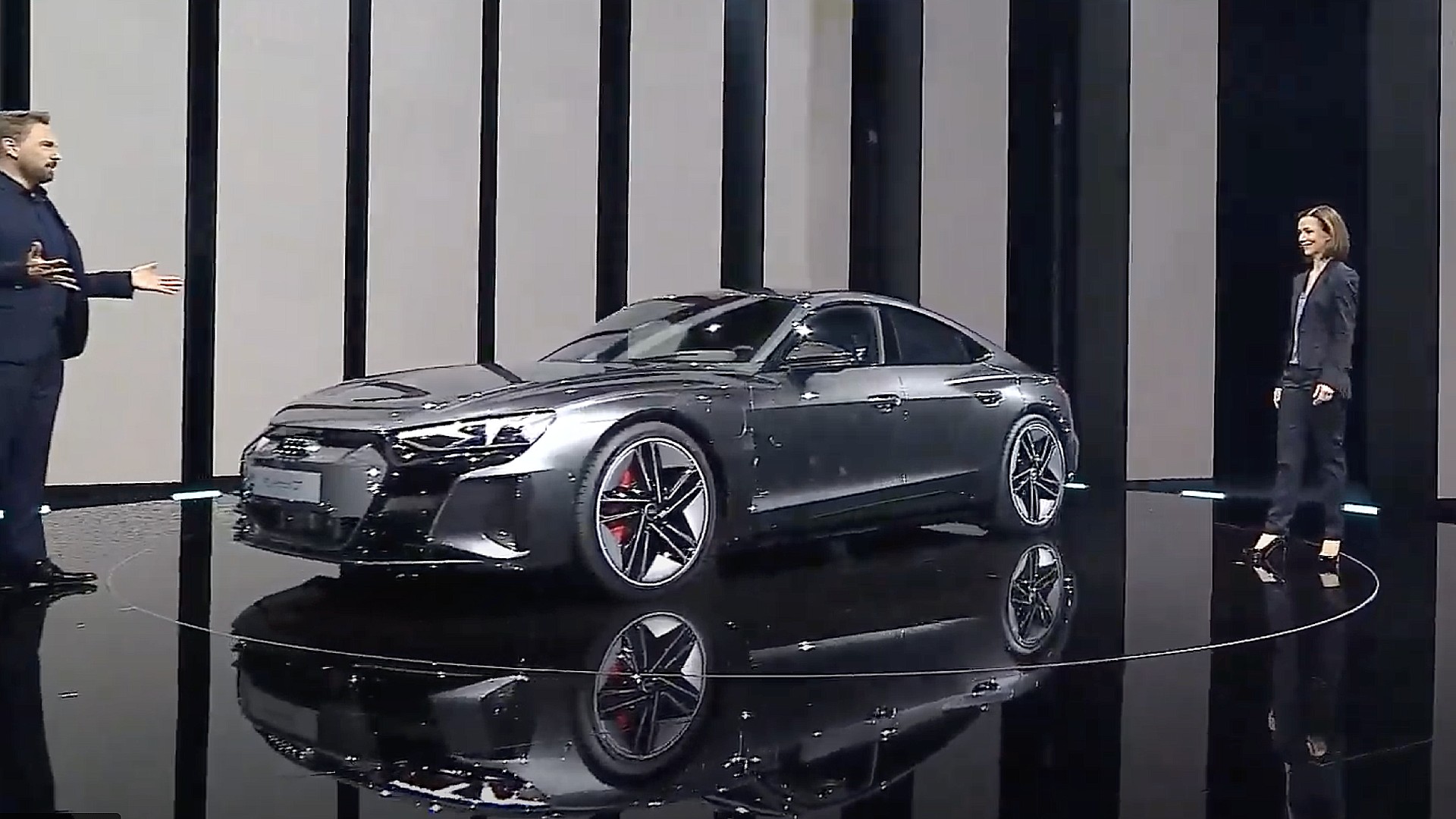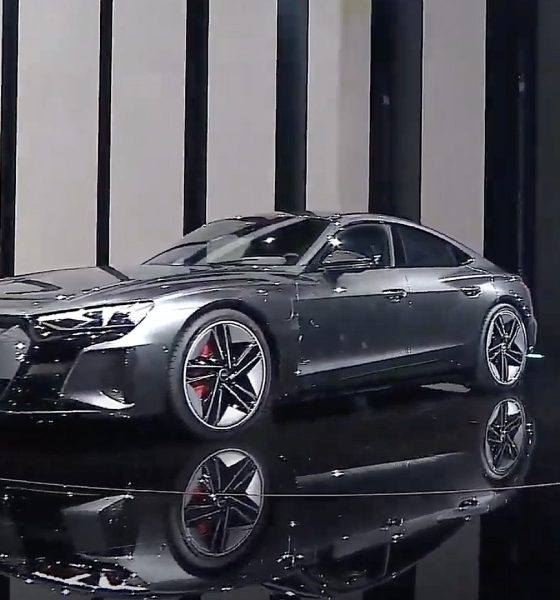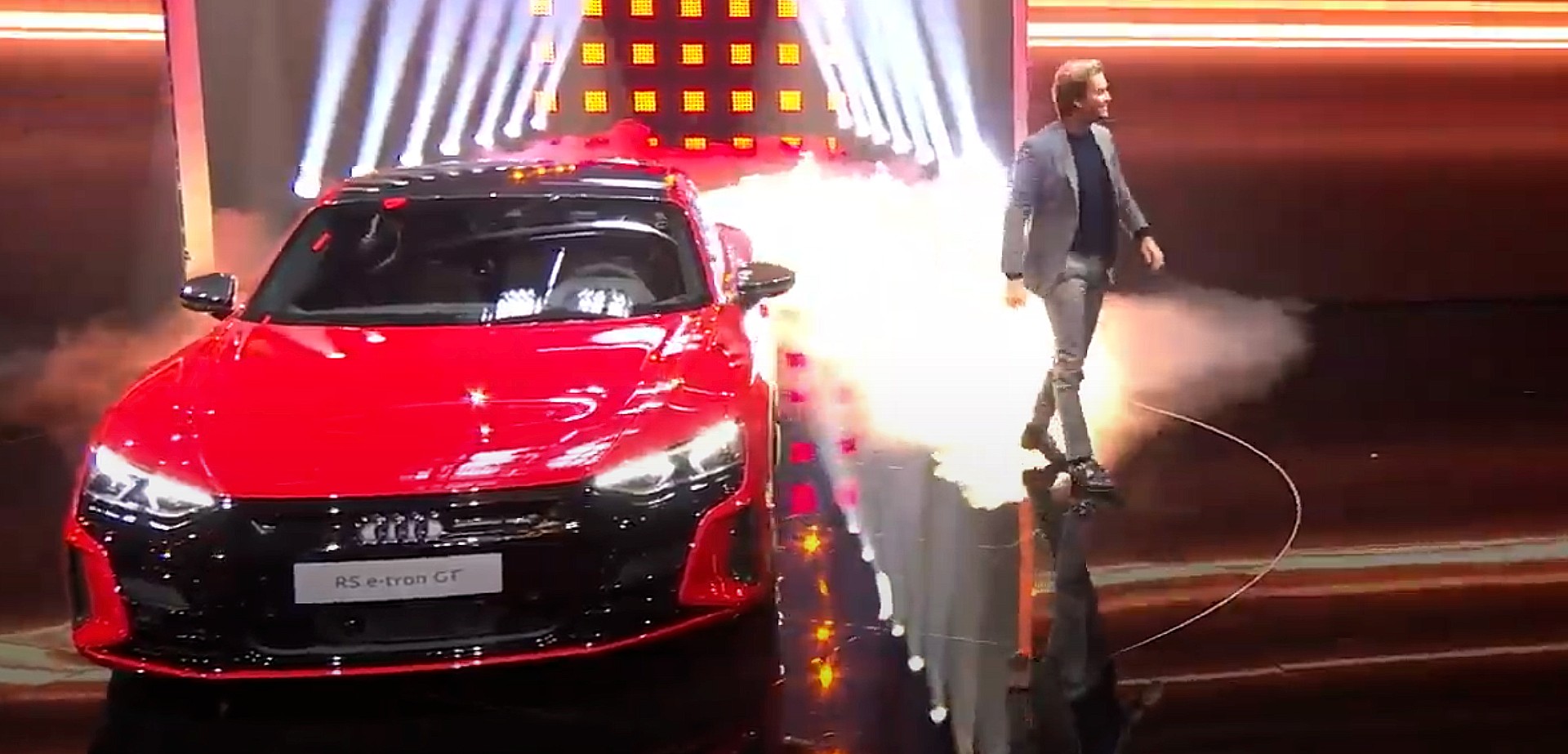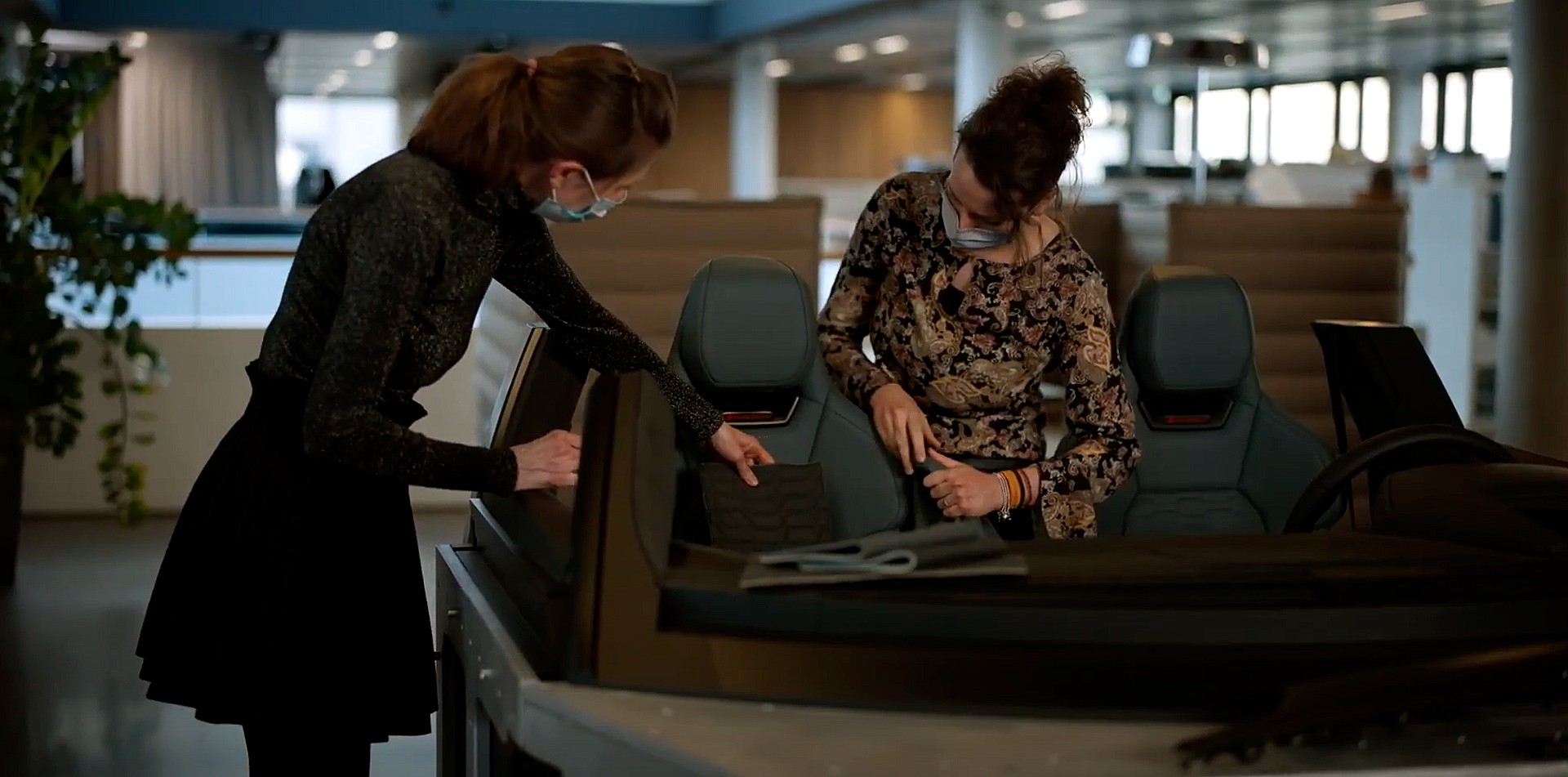

News
Audi debuts e-tron GT: 293 mile range, 155 MPH top speed, 590 HP, $99,900 starting price
German automaker Audi has unveiled its newest all-electric vehicle: the e-Tron GT. The e-tron offers between 269 and 293 miles of WLTP-estimated range with several different variants, a top speed of 155 MPH, and a 3.3 second 0-62 MPH time. The new e-tron will start at $99,000.
Audi unveiled the e-tron during a live event on February 9th, detailing the exterior and interior design, as well as the vehicle’s specifications and performance figures. The e-tron GT aims to bring world-class performance to an all-electric platform as Audi begins to transition to a more broad offering of EVs for the future, with plans to offer more than 30 cars by 2025. Audi says 20 of these cars will be fully-electric.
A new era of thrill is about to begin.
Like this tweet to be among the first to see the all-new, all-electric #etronGT, launching February 9th at 1 PM ET / 10 AM PT.
— Audi USA (@Audi) February 8, 2021
Audi e-tron GT: the embodiment of Audi
The introduction of the e-tron GT “perfectly embodies Audi’s innovative and pioneering spirit,” Hildegard Wortman, Member of the Board of Management of Audi AG for Sales and Marketing, said. The e-tron will offer four-wheel steering, along with torque vectoring for improved handling.
With range offerings between 269 and 293 miles (433 and 472 kilometers), the e-tron will offer plenty of driving range for travelers far and wide. Additionally, Audi stated that the vehicle’s 95 kWh battery pack would have the ability to charge from 0 to 80% in less than 23 minutes when plugged into a 700kW station. Audi focused heavily on aerodynamics to complement the range ratings, and stated the vehicle has a .24 drag coefficient.

Audi e-tron RS GT: the most powerful Audi ever
Audi’s premier, top of the line GT variant will be the RS. Its 0-60 MPH in 3.1 seconds is lightning fast and will compete with some of the quickest electric cars in the world. Additionally, a top speed of 155 MPH gives it a face-melting maximum rate of travel, although it will rarely be reached by the traditional driver.
Niko Rosberg, a former Formula One World Champion noted that the RS GT’s performance was one of a kind. The four-wheel steering system combined with the performance specifications offered one of the most unique driving experiences from a production car he’s ever experienced. Rosberg spoke highly of the GT’s performance variant, adding that it was unbelievable to drive an all-electric powertrain with the power, acceleration, and speed that was reminiscent of his F1 days.

Sustainable interior materials for unmatched environmental consciousness
One of the main focuses of Audi moving forward is to reduce greenhouse gas emissions during the vehicle’s life cycle. This begins with the manufacturing process, which Audi detailed in its goals to be CO2 neutral by 2025. The e-tron GT’s manufacturing facility is fully-powered by renewable energy, making the production process Earth-friendly.
Additionally, Audi looked to use sustainable materials within its interior. One focus was to eliminate waste within the vehicle by using sustainably-sourced materials that could be recycled when the car reaches the end of its cycle. The seats within the e-tron GT use around 99% of zero-waste materials, making it one of the most sustainable interiors in the automotive market.

The 2022 Audi e-tron GT starts at $99,900 plus destination fees, which haven’t been defined by the automaker yet. The RS e-tron GT will be $139,900, Autoblog says. The car is expected to begin sales later this summer.
Audi’s full unveiling of the e-tron GT is available below.
https://youtu.be/StkkIdBY5r0

Elon Musk
Elon Musk’s X will start using a Tesla-like software update strategy
The initiative seems designed to accelerate updates to the social media platform, while maintaining maximum transparency.

Elon Musk’s social media platform X will adopt a Tesla-esque approach to software updates for its algorithm.
The initiative seems designed to accelerate updates to the social media platform, while maintaining maximum transparency.
X’s updates to its updates
As per Musk in a post on X, the social media company will be making a new algorithm to determine what organic and advertising posts are recommended to users. These updates would then be repeated every four weeks.
“We will make the new 𝕏 algorithm, including all code used to determine what organic and advertising posts are recommended to users, open source in 7 days. This will be repeated every 4 weeks, with comprehensive developer notes, to help you understand what changed,” Musk wrote in his post.
The initiative somewhat mirrors Tesla’s over-the-air update model, where vehicle software is regularly refined and pushed to users with detailed release notes. This should allow users to better understand the details of X’s every update and foster a healthy feedback loop for the social media platform.
xAI and X
X, formerly Twitter, has been acquired by Elon Musk’s artificial intelligence startup, xAI last year. Since then, xAI has seen a rapid rise in valuation. Following the company’s the company’s upsized $20 billion Series E funding round, estimates now suggest that xAI is worth tens about $230 to $235 billion. That’s several times larger than Tesla when Elon Musk received his controversial 2018 CEO Performance Award.
As per xAI, the Series E funding round attracted a diverse group of investors, including Valor Equity Partners, Stepstone Group, Fidelity Management & Research Company, Qatar Investment Authority, MGX, and Baron Capital Group, among others. Strategic partners NVIDIA and Cisco Investments also continued support for building the world’s largest GPU clusters.
News
Tesla FSD Supervised wins MotorTrend’s Best Driver Assistance Award
The decision marks a notable reversal for the publication from prior years, with judges citing major real-world improvements that pushed Tesla’s latest FSD software ahead of every competing ADAS system.

Tesla’s Full Self-Driving (Supervised) system has been named the best driver-assistance technology on the market, earning top honors at the 2026 MotorTrend Best Tech Awards.
The decision marks a notable reversal for the publication from prior years, with judges citing major real-world improvements that pushed Tesla’s latest FSD software ahead of every competing ADAS system. And it wasn’t even close.
MotorTrend reverses course
MotorTrend awarded Tesla FSD (Supervised) its 2026 Best Tech Driver Assistance title after extensive testing of the latest v14 software. The publication acknowledged that it had previously criticized earlier versions of FSD for erratic behavior and near-miss incidents, ultimately favoring rivals such as GM’s Super Cruise in earlier evaluations.
According to MotorTrend, the newest iteration of FSD resolved many of those shortcomings. Testers said v14 showed far smoother behavior in complex urban scenarios, including unprotected left turns, traffic circles, emergency vehicles, and dense city streets. While the system still requires constant driver supervision, judges concluded that no other advanced driver-assistance system currently matches its breadth of capability.
Unlike rival systems that rely on combinations of cameras, radar, lidar, and mapped highways, Tesla’s FSD operates using a camera-only approach and is capable of driving on city streets, rural roads, and freeways. MotorTrend stated that pure utility, the ability to handle nearly all road types, ultimately separated FSD from competitors like Ford BlueCruise, GM Super Cruise, and BMW’s Highway Assistant.
High cost and high capability
MotorTrend also addressed FSD’s pricing, which remains significantly higher than rival systems. Tesla currently charges $8,000 for a one-time purchase or $99 per month for a subscription, compared with far lower upfront and subscription costs from other automakers. The publication noted that the premium is justified given FSD’s unmatched scope and continuous software evolution.
Safety remained a central focus of the evaluation. While testers reported collision-free operation over thousands of miles, they noted ongoing concerns around FSD’s configurable driving modes, including options that allow aggressive driving and speeds beyond posted limits. MotorTrend emphasized that, like all Level 2 systems, FSD still depends on a fully attentive human driver at all times.
Despite those caveats, the publication concluded that Tesla’s rapid software progress fundamentally reshaped the competitive landscape. For drivers seeking the most capable hands-on driver-assistance system available today, MotorTrend concluded Tesla FSD (Supervised) now stands alone at the top.
News
Elon Musk’s Grokipedia surges to 5.6M articles, almost 79% of English Wikipedia
The explosive growth marks a major milestone for the AI-powered online encyclopedia, which was launched by Elon Musk’s xAI just months ago.

Elon Musk’s Grokipedia has grown to an impressive 5,615,201 articles as of today, closing in on 79% of the English Wikipedia’s current total of 7,119,376 articles.
The explosive growth marks a major milestone for the AI-powered online encyclopedia, which was launched by Elon Musk’s xAI just months ago. Needless to say, it would only be a matter of time before Grokipedia exceeds English Wikipedia in sheer volume.
Grokipedia’s rapid growth
xAI’s vision for Grokipedia emphasizes neutrality, while Grok’s reasoning capabilities allow for fast drafting and fact-checking. When Elon Musk announced the initiative in late September 2025, he noted that Grokipedia would be an improvement to Wikipedia because it would be designed to avoid bias.
At the time, Musk noted that Grokipedia “is a necessary step towards the xAI goal of understanding the Universe.”
Grokipedia was launched in late October, and while xAI was careful to list it only as Version 0.1 at the time, the online encyclopedia immediately earned praise. Wikipedia co-founder Larry Sanger highlighted the project’s innovative approach, noting how it leverages AI to fill knowledge gaps and enable rapid updates. Netizens also observed how Grokipedia tends to present articles in a more objective manner compared to Wikipedia, which is edited by humans.
Elon Musk’s ambitious plans
With 5,615,201 total articles, Grokipedia has now grown to almost 79% of English Wikipedia’s article base. This is incredibly quick, though Grokipedia remains text-only for now. xAI, for its part, has now updated the online encyclopedia’s iteration to v0.2.
Elon Musk has shared bold ideas for Grokipedia, including sending a record of the entire knowledge base to space as part of xAI’s mission to preserve and expand human understanding. At some point, Musk stated that Grokipedia will be renamed to Encyclopedia Galactica, and it will be sent to the cosmos.
“When Grokipedia is good enough (long way to go), we will change the name to Encyclopedia Galactica. It will be an open source distillation of all knowledge, including audio, images and video. Join xAI to help build the sci-fi version of the Library of Alexandria!” Musk wrote, adding in a later post that “Copies will be etched in stone and sent to the Moon, Mars and beyond. This time, it will not be lost.”








